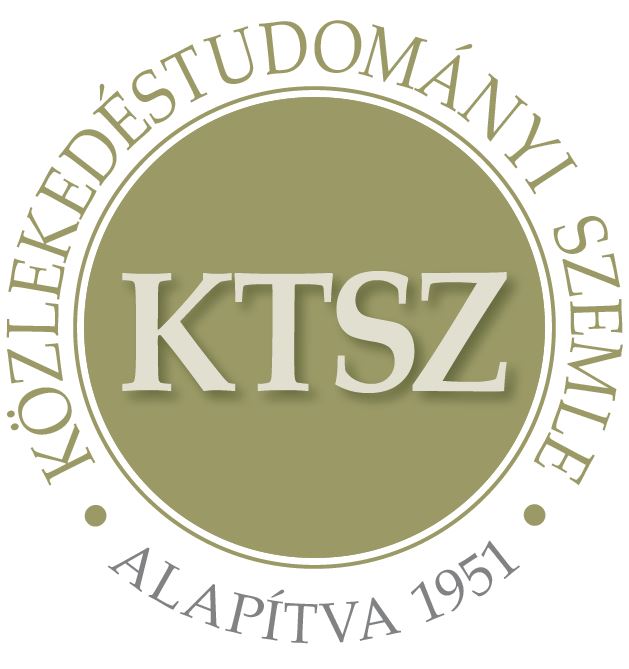Impact assessment of changes in Budapest speed limits with traffic simulation
Abstract
Road traffic congestion has now become virtually an everyday phenomenon on the roads of big cities around the world. The explanation for this is clear: the capacity of transport networks becomes saturated during peak hours, so the increasing demands cannot be adequately served, not even by the operation of traffic-dependent traffic light control. Several methods are being experimented with in order to improve the situation: their essence is that these measures are effective.
References
I.K., Harding, T., Westby, B.S.: Going fast or going green? Evidence from environmental speed limits in Norway, Transportation Research Part D: Transport and Environment, Vol. 82, 2020,102261, ISSN 1361-9209, DOI: http://doi.org/d7gj
Archer, J., Fotheringham, N., Symmons, M., & Corben, B.: The impact of lowered speed limits in urban/metropolitan areas. Monash University Accident Research Center and Transport Accident Commission, Vol 276, pp. 7–14., 2008, https://www.monash.edu/__data/assets/pdf_file/0007/216736/The-impact-oflowered-speed-limits-in-urban-andmetropolitan-areas.pdf
Török Á., Zöldy M.: Energetic and economical investigation of greenhouse gas emission of Hungarian road transport sector, Pollack Periodica, 5(3), 123-132. Retrieved Jun 22, 2020, from https://akjournals.com/view/journals/606/5/3/article-p123.xml DOI: http://doi.org/d3vxfp
Szele, A., Kisgyörgy, L.: Traffic Management of the Congested Urban-suburban Arterial Roads, Periodica Polytechnica Civil Engineering, 63(4), pp. 1103-1111, 2019. DOI: http://doi.org/d7gk
Nilsson G.: Traffic safety dimensions and the power model to describe the effect of speed on safety. Bulletin 221, Lund Institute of Technology, Lund, Sweden, 2004, https://lup.lub.lu.se/search/ws/files/4394446/1693353.pdf
Ang, A., Christensen, P., Vieira, R.: Should congested cities reduce their speed limits? Evidence from São Paulo, Brazil, Journal of Public Economics, Volume 184, 2020, 104155, DOI: http://doi.org/gg6zm7
Tang, J., McNabola, A., Misstear, B., Pilla, F. and Alam, M.S., 2019. Assessing the impact of vehicle speed limits and fleet composition on air quality near a school. International journal of environmental research and public health, 16(1), p.149. https://www.mdpi.com/1660-4601/16/1/149/pdf DOI: http://doi.org/d7gm
Keller, M., Hausberger, S., Matzer, C., Wüthrich, P., & Notter, B. (2017). HBEFA Version 3.3. Background documentation, Berne, 12.
Olstam, Johan Janson, and Andreas Tapani: Comparison of Car-following models. Vol. 960. Linköping: Swedish National Road and Transport Research Institute, 2004
Hammer, Emanuel, et al.: Traffic noise emission modelling at lower speeds. Conference Proceeding ICSV. Vol. 2016. 2016
Articles published electronically are open access (OJS), freely available online and can be downloaded. Authors of articles are not charged any publication or publishing costs (APC). Users have the right to read, download, copy, print, and search the articles, or share the full text with a link.
Authors must declare that their submission has not been previously published in another journal, that financial support has been acknowledged, and that the list of references is complete and accurate, including specification of URLs and DOIs (if available). When submitting a draft article, each author approves the submitted version. Authors guarantee that the article is their original work. Authors are required to participate in the peer review process, follow the advice of reviewers, meet the prescribed deadlines, and, if any, withdraw the submission or correct errors.
All submitted articles are subject to peer review, where the editors request an independent evaluation from at least one expert, ensuring that the reviewer(s) have no conflicts of interest with the authors. The final decision is made by the Editor-in-Chief, who takes into account the evaluations and the suggestions of the editors. The editors and reviewers treat the submission confidentially.
The publisher and editors are committed to maintaining high ethical standards and to preventing publications that involve research misconduct. They follow the COPE guidelines on such ethical issues.
The authors retain copyright and grant the journal the right of first publication under the Creative Commons License (https://creativecommons.org/licenses/by-nc-nd/4.0), which allows others to share the work, while acknowledging the authorship of the work and the first publication in the journal.
The journal archives all published articles, and the journal's owner, the Hungarian Society of Transportation Sciences, will continue to operate the database even if the journal ceases to be published.















